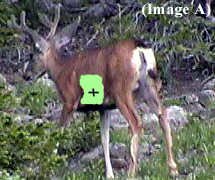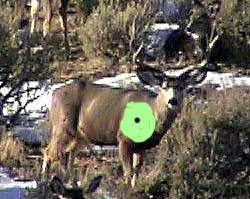Shot Placement
 This hunting tip deals with making your shot
count. Whether hunting with a bow, muzzleloader, or a rifle, good bullet or arrow placement
is essential. Nobody wants to hike back to camp and tell his or her hunting buddies, "I hit
a buck, but lost the blood trail because it was a poor shot".
This hunting tip deals with making your shot
count. Whether hunting with a bow, muzzleloader, or a rifle, good bullet or arrow placement
is essential. Nobody wants to hike back to camp and tell his or her hunting buddies, "I hit
a buck, but lost the blood trail because it was a poor shot".
Taking the right shot, and placing the arrow or bullet properly can be the difference between a successful hunt and a hunt that ends with you wondering if the buck would recover or not.
We will begin by talking about arrow placement. Because the average bow can only launch an arrow at about 260 feet per second, it is essential that you avoid hitting bone. There is no better way to loose an animal than hitting it in the shoulder. Never aim at the shoulder with a bow. The best arrow placement is just behind the shoulder and in the lower half of the buck's body. (See Image A)
A bucks body position is also very important. It is never a good idea to shoot an arrow at a buck that's facing straight at you, straight away from you, or angled towards you. Doing so decreases the size of the kill zone and increases the chance that you will hit bone, or worse a gut shot! You will also see in (Image A) that the angle at which the buck is standing is just right. If you can place your shot into the yellowed section, you will most likely find your buck.
 Now, look at (Images B & C). Both of the bucks are positioned
poorly, do not shoot! On both of these bucks, the kill zone is very small, or
non-existent. You have a better chance of wounding, and never finding these bucks, than
hitting the small kill zone.
Now, look at (Images B & C). Both of the bucks are positioned
poorly, do not shoot! On both of these bucks, the kill zone is very small, or
non-existent. You have a better chance of wounding, and never finding these bucks, than
hitting the small kill zone.
Ok, you feel comfortable as to where to aim with your bow. Alright, let's talk about bullet placement. Because a bullet travels so fast and carries so much energy, hitting an animal in the shoulder is often the best shot. There are exceptions however. For example, some of the older muzzleloaders just aren't fast enough to penetrate the bone and enter the body cavity. Many muzzleloader hunters have had the experience of shooting a buck, knocking the buck down, only to see him jump up and run or hobble off with no sign of blood. The reason for this, is that the bullet was plenty heavy to knock the deer down, but not fast enough to continue through the bone or muscle and into the body cavity. It happens especially when shooting at larger bodied bucks.
 For those who hunt with muzzleloaders, it is a good idea to
know and understand what your gun can do. One way to know just how much penetration power
you have is to take a couple 2x6 inch pieces of lumber with you to the shooting range. Set
them together so that you have about 4 inches of solid lumber. Then at different distances,
shoot some holes into them. If your bullet penetrates all 4 inches of lumber, it will
probably penetrate through deer bone and muscle. You will notice that as you move from 50
yards, to 100 yards, and to 170 yards, that the bullet does not penetrate as deep. You will
then know just how much penetration power your gun packs.
For those who hunt with muzzleloaders, it is a good idea to
know and understand what your gun can do. One way to know just how much penetration power
you have is to take a couple 2x6 inch pieces of lumber with you to the shooting range. Set
them together so that you have about 4 inches of solid lumber. Then at different distances,
shoot some holes into them. If your bullet penetrates all 4 inches of lumber, it will
probably penetrate through deer bone and muscle. You will notice that as you move from 50
yards, to 100 yards, and to 170 yards, that the bullet does not penetrate as deep. You will
then know just how much penetration power your gun packs.
Almost any high powered rifle, shooting a bullet made for big game, should have no problem penetrating bone and entering the body cavity. Therefore, a good shoulder, or base of the neck shot is best. (Image D) shows the kill zone for a rifle.
Remember that shot placement is very important, and it is essential if a hunter hopes to be successful.
Good Hunting!
Click-a-Pic ... Details & Bigger Photos
Click-a-Pic ... Details & Bigger Photos
Videos | Hunts & Tags | About Mule Deer | About Elk
Classified Ads | Photo Tours | About this Site | Advertising |
Older Content | Email Us | Privacy Policy
